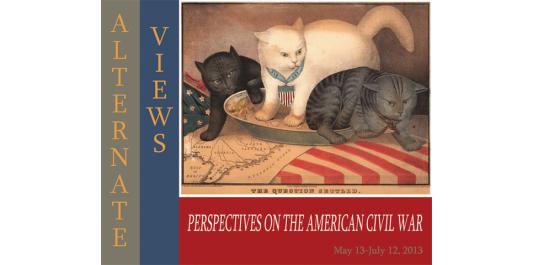Past Exhibits
 Eye of the Cartoonist: Daniel Clowes's Selections from Comics History May 17, 2014 - August 3, 2014
Eye of the Cartoonist: Daniel Clowes's Selections from Comics History May 17, 2014 - August 3, 2014 Image: Chester Gould, Dick Tracy, May 29, 1960. Chester Gould Collection.
Take a look through cartoonist Daniel Clowes’s incredibly informed, sometimes surprising historical perspective. Ohio State’s Billy Ireland Cartoon Library & Museum is the world’s largest repository of cartoon art. To complement his survey concurrently on view, we invited Clowes—who, like many cartoonists, is a great student of his field’s history—to collaborate with the museum’s curators in presenting an exhibition of work by past greats whom he admires or considers influences. In works such as the comic book anthology series Eightball (1989–2004) and the graphic novel Wilson (2010), Clowes illustrates in a wide spectrum of styles that often incorporate, adapt, and comment on touchstones from comics history. Drawing from the museum’s collection, the work on view in this exhibition at the Wex illuminates Clowes’s range, encompassing Chester Gould’s hard-boiled detective strip Dick Tracy, the minimal elegance of Otto Soglow’s The Little King, the Art Nouveau–inspired fantasias of Winsor McCay’s Little Nemo in Slumberland, the action-adventure stories of Terry and the Pirates (created by Ohio State’s own Milton Caniff), and even the ever-popular Peanuts by Charles Schulz.
 Exploring Calvin and Hobbes March 22, 2014 - August 3, 2014
Exploring Calvin and Hobbes March 22, 2014 - August 3, 2014 Image © Bill Watterson.
Exploring Calvin and Hobbes revisits the beloved comic strip created by Bill Watterson from 1985-1995. The exhibition will feature original Calvin and Hobbes dailies and Sundays as well as specialty pieces by Watterson from his collection of more than 3,000 originals housed at the BICLM. This is only the second exhibition devoted to Calvin and Hobbes, which appeared in 2,400 newspapers worldwide at the height of its popularity. Watterson won the National Cartoonists Society’s prestigious Reuben Award for “Outstanding Cartoonist of the Year” in both 1986 and 1988.
Six-year-old Calvin, named after the 16th-century theologian John Calvin, has a vivid imagination; an aversion to homework, chores, and girls; and a penchant for discussing the meaning of life. Hobbes, named for the 17th-century British philosopher Thomas Hobbes, appears to most of the strips’ characters as a stuffed animal, but from Calvin’s perspective, he is a living, breathing—sometimes even dangerous—tiger. He’s also a best friend, a playmate, a co-conspirator, and occasionally the voice of reason. The strip follows the two as they navigate the bumpy ride of life, surrounded by a supporting cast that includes Calvin’s parents, his neighbor Susie, his babysitter Rosalyn, the school bully Moe, and his teacher, Mrs. Wormwood.
 The Irresistible Force Meets the Immovable Object: A Richard Thompson Retrospective March 22, 2014 - August 3, 2014
The Irresistible Force Meets the Immovable Object: A Richard Thompson Retrospective March 22, 2014 - August 3, 2014 Image © Richard Thompson.
Richard Thompson, the 2011 winner of the Reuben Award for “Outstanding Cartoonist of the Year,” will be featured in the exhibition, The Irresistible Force Meets the Immovable Object: A Richard Thompson Retrospective. This exhibit, curated by Caitlin McGurk, will not only include gorgeously hand-watercolored Sunday originals and black-and-white dailies from Thompson’s popular comic strip Cul de Sac, but will celebrate his lesser-known abilities as a master of caricature, gags, and editorial cartoons— both as cartoonist and painter.
 Substance and Shadow: The Art of the Cartoon November 16, 2013 - March 2, 2014
Substance and Shadow: The Art of the Cartoon November 16, 2013 - March 2, 2014 Substance and Shadow refers to the dual meaning of John Leech’s “Cartoon, No. 1,” but also describes the essence of cartoon art in general. Cartoons are substance and shadow, content and technique. Cartoonists communicate their ideas graphically with bold lines and subtle shading.
A cartoon is a combination of words and pictures that can tell a story, share a thought, articulate an emotion, promote a point of view, or make people laugh. Cartoonists have mastered an almost limitless vocabulary of graphic expression to entertain and enlighten a mass audience. In spite of the popularity of cartoons, the creative process that cartoonists use to conceive and produce their art still remains a mystery to most of the general public.
This exhibition showcases original art from the collection of the Billy Ireland Cartoon Library & Museum which dramatically reveals the various elements, methods, tools and techniques that cartoonists utilize, including caricature, character design, sequential panels, speech balloons page, layout, animation and storytelling.
 Alternate Views: Perspectives on the American Civil War May 13, 2013 - July 12, 2013
Alternate Views: Perspectives on the American Civil War May 13, 2013 - July 12, 2013 The 150th Anniversary of the American Civil War is commemorated in this exhibition which highlights the Billy Ireland Cartoon Library & Museum’s growing collection of nineteenth century prints. Editorial cartoons were not published in newspapers until after the Civil War when technology made it possible to publish them economically in a timely way. Prior to that, broadsheet prints – etchings, engravings and lithographs – were the means cartoonists used for political commentary. Popular magazines such as Harper’s Weekly relied on wood engravings to provide illustrations.

